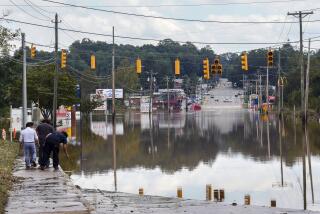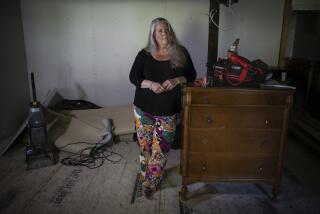Missouri’s Flood-Weary Officials Start Tackling Tough Job of Cleanup : Disaster: They attend ‘summit’ to discuss next steps. They are told that $5.8-billion federal relief package would be less than what’s needed.
JEFFERSON CITY, Mo. — With the sandbagging, the dramatic rescue efforts and the hurried evacuations largely over, local officials from across this flood-ravaged state began what may be the hardest labor of all--cleaning up.
Hundreds of mayors, city engineers, emergency management coordinators and others from throughout Missouri gathered at a “flood summit” on Saturday organized by Gov. Mel Carnahan. The original session was canceled last week because the capital itself was battered by floodwater from the overflowing Missouri River.
Still, many local officials did not attend because the crises in their communities remained acute. Some of those who did attend had to drive hundreds of miles along back roads because many of the state’s major highways are closed. One mayor had to take a boat 10 miles and then borrow a car to make it to the session.
The message they found was a mixed one. Aid would be forthcoming thanks to a $5.8-billion flood relief package that cleared Congress, and all state agencies would be focusing on flood relief.
But the assistance would be less than what is needed, officials warned, and would go to the most heavily damaged regions first.
Although most damage estimates are only guesses until the water recedes, Missouri itself is considered the hardest-hit state in the Midwest, with an estimated $4 billion in losses. Nearly 3,200 businesses were hit by floodwater and an estimated 25,000 workers have been laid off. The floods reached 15,000 homes and caused more than $120 million in damage to roads and bridges, state officials say.
Even with the massive federal aid package, Agriculture Secretary Mike Espy warned: “You know and I know that that is not enough. The federal government cannot make you whole.”
Jerry Uhlmann, director of the state Emergency Management Agency, encouraged the officials at the summit to start their cleanup efforts with the same volunteers who were so essential in putting up sandbag levees along the river.
Throughout the day, officials from scores of Missouri communities jotted down tips, gathered brochures and made their cases for assistance to whomever they could corner.
“Chesterfield has the largest concentration of damaged businesses in the Midwest,” said Thom Sehnert, who owns one of those businesses, the Smoke House Market. “We have 486 businesses within nine square miles that are underwater.”
Dan Boyce, the engineer for the tiny town of Washington, east of St. Louis, said the water treatment plant, the airport and a dozen homes in his city were flooded. “There may be some cities worse off, but there can’t be too many,” he said.
Some officials said they were encouraged by some of what they heard. There were toll-free telephone numbers set up by many state agencies, and the state highway chief offered to assist removing the sandbags from flooded towns.
But there was frustration as well. The paperwork seemed endless, many of the participants complained, and some of the documents that agencies were requesting were waterlogged.
“Document everything,” one state official warned in a session dealing with the bureaucratic tangles of flood aid. “Take pictures and keep every record you can. Write down everything ‘cause one of these agencies is gonna ask for it.”
More to Read
Sign up for Essential California
The most important California stories and recommendations in your inbox every morning.
You may occasionally receive promotional content from the Los Angeles Times.










